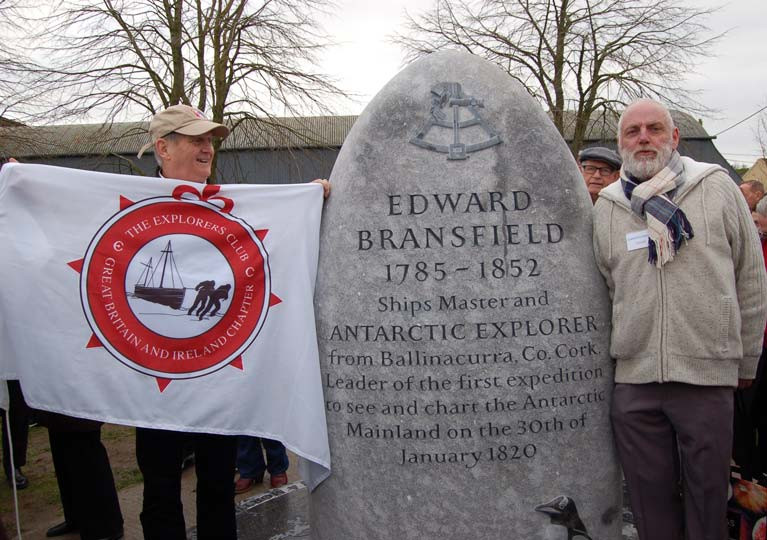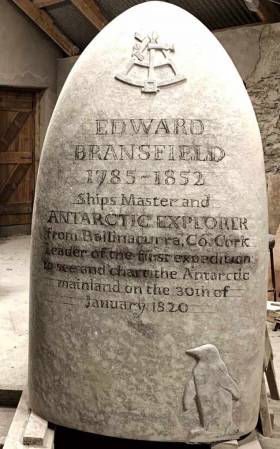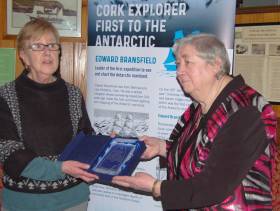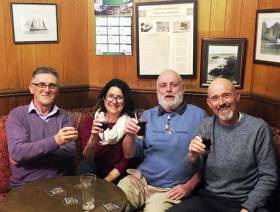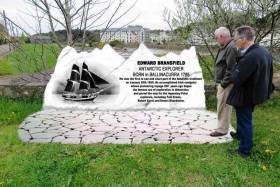Displaying items by tag: Edward Bransfield
Cork Harbour Seafarer Edward Bransfield Honoured in Ballinacurra
Ireland is not good at recognising and honouring the achievements of its mariners.
The Chief of Staff of the Defence Forces made that point at the unveiling of the long-awaited memorial to Cork seafarer, Edward Bransfield, at Ballinacurra in East Cork on the edge of Cork Harbour on Saturday, January 25.
Several hundred people were present. “Beyond our wildest dreams,” said Chairman of the Memorial Committee, Jim Wilson, describing the attendance.
We have followed on Afloat. ie and reported how the Committee has campaigned for several years to erect the memorial to honour the memory of Bransfield, the Irish-born navigator and commander of the British Navy’s expedition, the first to see and chart the Antarctic mainland on January 30, 1820. “He made the first confirmed sighting and maps of the Antarctic mainland and arguably the continent 200 years ago,” said Wilson. Antarctica is the fifth largest Continent on Earth, covers the South Pole and is sheeted in ice. Bransfield had been ‘press-ganged’ – forced into the British Navy – as a youngster when he was forcefully taken from his father’s fishing boat in Cork Harbour.
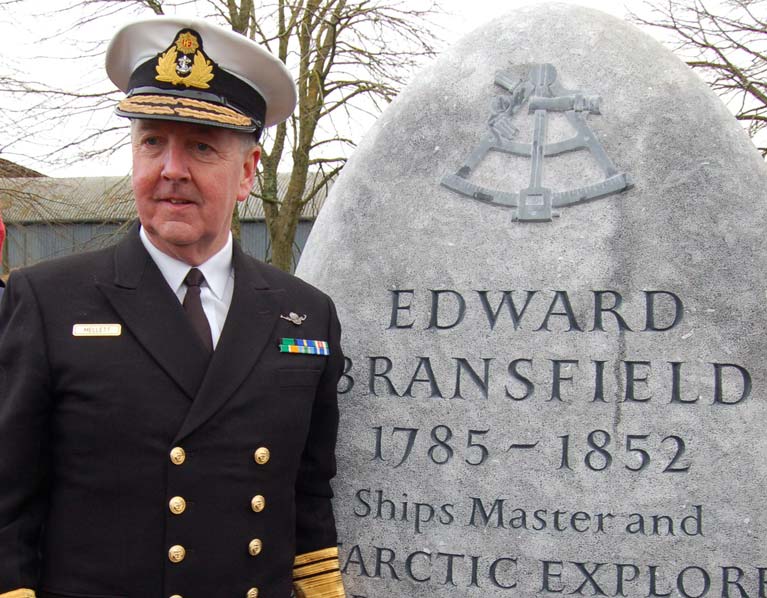 Chief of Staff of the Irish Defence Forces, Vice Admiral Mark Mellett at the Bransfield Memorial
Chief of Staff of the Irish Defence Forces, Vice Admiral Mark Mellett at the Bransfield Memorial
The Chief of Staff of the Irish Defence Forces, Vice Admiral Mark Mellett, stressed the importance of honouring Ireland’s seafarers for what they had achieved. He made the keynote speech in which he said that a Russian claim that it was they had first seen Antarctica could not be proven from the records of the time, which showed that it was Bransfield. He said that Bransfield’s expeditionary achievement was amazing, in a wooden sailing ship, by comparison about a twelfth in size of the present Naval Service vessels
The head of the Naval Service, Flag Officer and Commodore, Michael Malone, was also in attendance.
Mr.Wlson said their presence was an important recognition of Edward Bransfield.
More on the Podcast below
A Beacon of Memory for Edward Bransfield, Discoverer of Antarctica
The well-known beacon at the entrance to Baltimore Harbour in West Cork has provided the idea for the memorial to the Irishman who discovered Antarctica.
In the cold, icy waters of the Southern Ocean, Edward Bransfield was keeping a lookout on a British expedition ship in January of 1820 when he saw Antarctica – the first man to set eyes on this vast icy continent.
A native of the village port and harbour of Ballinacurra in East Cork, he had been press-ganged - forced into service in the British Royal Navy, where he rose through the ranks to command.
So an Irishman, sailing under the British flag, was the first to set eyes on Antarctica. But, unlike Shackleton, Tom Crean and others, his name is not widely known, a regrettable failure of national knowledge about Irish mariners.
"An Irishman, sailing under the British flag, was the first to set eyes on Antarctica"
We’ve been reporting on Afloat the efforts of a local committee in East Cork to change this and they are very close to doing so, having raised the money to pay for a memorial which will be erected to his memory in Ballinacurra, near Midleton in January – 200 years after his discovery of Antarctica. Two weeks ago we reported that Ireland’s world sailor, Damian Foxall, will be leading voyages in the waters where several areas are named after Bransfield.
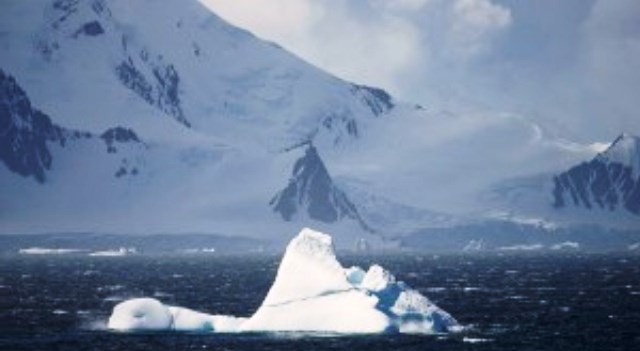 An iceberg In The Bransfield Strait, Antarctica
An iceberg In The Bransfield Strait, Antarctica
The sculptor, chosen to make the memorial is Matt Thompson whose workshop is at Churchtown, on a lovely stretch of the East Cork coastline, south of Ballycotton, as the coastal area winds onwards to Cork Harbour.
The Bransfield commission was challenging for him to decide on the type of memorial because of the lack of a photograph of the mariner.
“None exists. Despite intensive searching, we could not find a photograph of Edward Bransfield,” according to the memorial committee.
So a decision had to be made on what form the memorial would take.
Matt Thompson, who himself sailed in the harbour waters up to Ballinacurra, did not know a lot about Bransfield, much like the general public situation of lack of knowledge of the mariner, before the Ballinacurra memorial committee started its campaign. I went to his workshop to see the memorial, where he explained to me the connection with the Baltimore beacon with which sailors cruising the Cork coastline will be aware.
Listen to Sculptor Matt Thompson on the Podcast below.
The Legendary Mariners Of Ballinacurra
Hello and welcome to my weekly Podcast ….Tom MacSweeney here ….
Creenan’s hostelry in Ballinacurra village, close to the town of Midleton in East Cork is a hallowed place in the annals of sailing. On its walls hang photographs and documents chronicling the maritime history of which the family itself are a major part. Known to generations of sailors, professional and leisure, its history is renowned in the name of the family schooner, the Brooklands, whose trading in Irish waters, without an engine, is legendary. Amongst the famous stories of the vessel is that in 1946 she was the last trading schooner to use sail alone in Dublin Port.
There are many other stories about the Brooklands which I heard from the great Jacko Creenan in an upstairs room of the family pub many years ago and which I regard as one of the most enjoyable radio interviews I ever recorded.
Amongst the famous stories of the vessel is that in 1946 she was the last trading schooner to use sail alone in Dublin Port.
I was back in Creenans to mark a special anniversary this week– that of a mariner from the village whose contribution to Polar exploration has not got the attention it should, but which a dedicated group has been gathering in Creenans for the past two years, intent on changing that – and they have advanced quite a lot in their pursuit.
He was Edward Bransfield who, in the era of the Napoleonic Wars, was a young man 18-years-old at the time, was press-ganged by the British Royal Navy from his father’s fishing boat to fill the crews needed by their warships. Amazingly, he rose to command the brig named Williams, the Royal Navy’s ship on which he became the first man to sight Antarctica.
From the village of Ballinacurra, then a port, now regrettably silted up, no longer commercially viable and even challenging for leisure craft to enter, this is a man to be remembered and acknowledged with pride. Ireland hasn’t done that. It should and the dedicated group campaigning to change that has commissioned a memorial to honour him which will be erected at the village waterside in 2020, two hundred years from the time on the 30th of January 1820 when he sighted the previously uncharted lands south of Cape Horn that are Antarctica.
Marking the Creenan family’s historic maritime connections and the support of Nena Creenan in providing the place where the committee meets and runs its campaign in Creenan’s hostelry, I gathered with them to mark the anniversary of the death of Edward Bransfield on the 31st of October 1852 and for which they presented the first of the mementoes which have been made to honour him..
It was good to be back in Creenan’s again and to be part of the honouring of yet another Ballinacurra mariner – Edward Bransfield.
Listen to the podcast below
Dedicated Volunteers Driving Maritime Change
Ireland is a nation which has been slow to recognise its maritime resources and its international maritime achievements made by Irish sailors. This I was reminded about again this week. But there are indications of changes for the better, driven by dedicated people, many of them local volunteers.
Some Cork volunteers want to make the name of Edward Bransfield, from the village of Ballinacurra in East Cork, nationally known for his discovery of Antarctica.
Eugene Furlong is one of the group’s leaders and I met him at the exhibition about Bransfield in Cork County Library, bringing their campaign to public attention.
They are progressing well in their campaign to have a monument erected to Edward Bransfield in 2020, the 200th anniversary of the time when he first saw Antartica..
They are determined to honour the man who was press-ganged from Cork Harbour in the British Royal Navy.
Listen to more of this story on the Podcast here.
Tom MacSweeney presents This Island Nation maritime radio programme.
Remembering Edward Bransfield Campaign Group Propose New Memorial
The campaign group ‘Remembering Edward Bransfield’ will hold an exhibition and series to talks this Friday night, August 25, at Midleton Library at 8 p.m.
Bransfield, born in Ballinacurra near Midleton, was the first man to see Antarctica, but has not been recognised for that, according to the group which says that “meticulous research has uncovered fascinating details about him.”
“There is a long and proud Cork/Antarctic connection. Of the ten Irish people involved in early Antarctic exploration, six are from Cork. Bransfield, was the first person to discover the location of Antarctica and to chart it in 1820,” says Eugene Furlong, one of the leaders of the Bransfield Group.
“This year, the theme for Heritage Week is our natural heritage therefore it is fitting that we celebrate the life of our local hero. The group ‘Remembering Edward Bransfield’ has produced an exhibition that details the meticulous research which has been undertaken and which has uncovered fascinating details of his personal life, his career and his unfailing courage.
“Everybody is welcome to the exhibition and talks and, as always with Cork County Library and Arts Service events, there is no cover charge.”


























